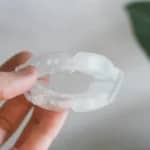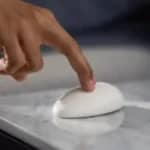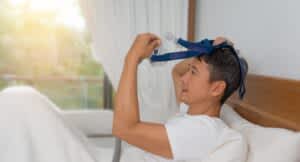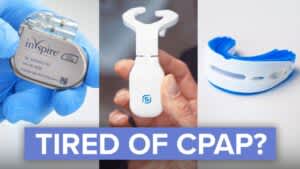Inspire is a medical device used to treat obstructive sleep apnea (OSA), a common disorder in which a person’s breathing repeatedly pauses during sleep. Inspire delivers a treatment for OSA by hypoglossal nerve stimulation, in which a small medical device is implanted in the body that helps to normalize nighttime breathing.
Breathing obstructions in people with OSA happens when tissues in and around the respiratory tract narrow or block a person’s airway during sleep. After diagnosis, often via a home sleep apnea test, the first-line approach to treating this condition is to use pressurized air to keep the airway open during sleep, most often delivered by a CPAP machine or similar device.
While positive airway pressure is often effective, many people have difficulty tolerating or consistently using their CPAP or other PAP device. For people who have tried PAP therapy without success, a doctor may recommend Inspire to improve nighttime breathing and reduce daytime symptoms of obstructive sleep apnea.
How Does the Inspire Sleep Apnea Device Work?
Inspire works while a person sleeps by gently stimulating nerves that control the tongue. Electrical impulses from the Inspire device cause the sleeper’s tongue and other structures in their mouth to shift forward. Shifting these tissues away from the throat increases the amount of space in the airway, thereby reducing the risk of an obstruction.
Treatment with Inspire begins with an outpatient surgery performed under general anesthesia. During the procedure, a doctor makes one small incision under the chin and one below the collarbone. They then place the Inspire device under the skin.
Once healed, the Inspire device can be programmed by a doctor and controlled by a small handheld remote control. To use Inspire, a person turns it on before bed. The device will then monitor the sleeper’s breathing and send out a gentle impulse to the muscles of the tongue every time they begin to inhale.

Does the Inspire Device Have FDA Approval?
Inspire is currently the only FDA-approved device that delivers hypoglossal nerve stimulation. The device was approved by the FDA for use in people who have failed or cannot tolerate PAP treatment and who meet certain criteria related to age, health, and the severity of their diagnosis.
Who Is a Candidate for Inspire Sleep Apnea Treatment?
To be a candidate for Inspire, a person must be evaluated by a doctor to determine if they are likely to benefit from hypoglossal nerve stimulation. Doctors take a variety of factors into account when determining a person’s eligibility for Inspire.
- Age and medical history: To qualify for Inspire, people must also be over 18 years old and have a body mass index (BMI) under 35. Several medical conditions may make a person ineligible for Inspire, including certain neuromuscular diseases, health issues that increase the risk of complications from anesthesia, and other sleep disorders.
- Severity of sleep apnea: Inspire is only recommended for people whose obstructive sleep apnea is considered moderate to severe. The severity of OSA is determined during a sleep study.
- Past treatment: Inspire is typically reserved for people with OSA who continue to have significant breathing disruptions despite trying a positive airway pressure device like CPAP or those who have CPAP intolerance.
Doctors will also check a person’s airway to ensure that Inspire is an appropriate treatment. This is done during a test called an endoscopy, where the doctor inserts a small camera to look at the structures of the mouth and throat.
What Is the Success Rate for the Inspire Device?
A 5-year study of Inspire found that it is effective at improving nighttime breathing, reducing daytime tiredness, and improving overall quality of life in people with obstructive sleep apnea.
The results of this study found that around 75% of people using Inspire have a significant reduction in nighttime breathing disruptions. Between 33% and 78% of people notice a significant improvement in feelings of daytime sleepiness. Up to 67% of people report a better quality of life after starting treatment with Inspire.
What Are Side Effects of Inspire Sleep Apnea Treatment?
Based on studies of people who have undergone Inspire and other forms of hypoglossal nerve stimulation, long-term side effects of this treatment are uncommon. When side effects do occur, they may include:
- Pain
- Infection
- Redness or swelling
- Scarring or other visible skin changes
- Equipment failure
- MRI-related restrictions and inference with other implants
Doctors typically monitor for potential side effects at regularly scheduled follow-up visits, which typically occur every 6 to 12 months.
Does Insurance Cover Inspire Sleep Apnea Treatment?
Insurance coverage for Inspire varies depending on an individual’s health insurance policy. Treatment with Inspire is covered by medicare for people who have failed PAP therapy and meet eligibility criteria.
According to Inspire Medical Systems, the company that created the Inspire device, the treatment is covered by most major health insurance companies in the United States. A person’s health insurance provider can provide more specific details about a person’s eligibility and coverage, including potential copays and other out-of-pocket expenses.
References
The Sleep Doctor Forum: Real Experiences, Real Connections
Continue the discussion on the Sleep Doctor Forum. Connect with experts and fellow forum members on CPAP, sleep apnea, and all things sleep. A priceless resource that’s free to join.



























